One of the challenges with face masks is that they often cover key facial features and expressions that are important for communicating speech and emotions. For many people, this means missing out on smiles, and having a little bit more trouble understanding other people in noisy environments. For people that are deaf, hard of hearing, or learning a language, the elimination of these facial cues poses even larger challenges. In response to some of these challenges during the COVID-19 pandemic, the CDC has suggested that clear face coverings, or window masks, may be appropriate.
In this post we’ll discuss three key considerations for the design of window masks — breathability, window material selection, and window attachment strategies — as well as 2 important considerations for their care and use — cleaning and disinfection and fogging. For one sewing pattern consistent with the advice below, see our MakerMask:Expression page.
Nota: “Masks” that are completely open at the sides, along the top, or under the chin function more like face shields than like masks, and won’t be discussed in this post.
CDC Statement About Clear Face Coverings in Schools
“Consider use of clear face coverings that cover the nose and wrap securely around the face by some teachers and staff. Clear face coverings should be determined not to cause any breathing difficulties or overheating for the wearer. Teachers and staff who may consider using clear face coverings include:
- Those who interact with students or staff who are deaf or hard of hearing, per the Individuals with Disabilities Education Act
- Teachers of young students learning to read
- Teachers of students in English as a second language classes
- Teachers of students with disabilities
Clear face coverings are not face shields. CDC does not recommend use of face shields for normal everyday activities or as a substitute for cloth face coverings because of a lack of evidence of their effectiveness for source control.”
#1 Breathability
Rule of Thumb: Window size should be no more than 1/3 of the breathable mask area.
Breathability is an important consideration for all face masks that cover the mouth and nose, and is especially important for window masks, since the clear plastics used as window materials are typically not breathable. In general, as the size of the window within the mask is increased, the breathability of the mask decreases, which increases issues with fogging, makes the mask feel hotter, and can pose problems for users with reduced lung function or those wearing them for prolonged periods of time.
As a general rule of thumb, no more than 1/3 of the breathable surface area of the finished mask should be constructed from the non-breathable window material. The exact ratio of breathable fabric to window size will depend on the mask design and the breathability of the fabrics used. It is important to note that portions of the mask material that are directly contacting the skin do NOT count as breathable surface area of the mask. So for well-fitted masks, the material in direct contact with the user’s face (e.g., the chin, the cheeks, and the top of the nose) doesn’t count as breathable surface area.
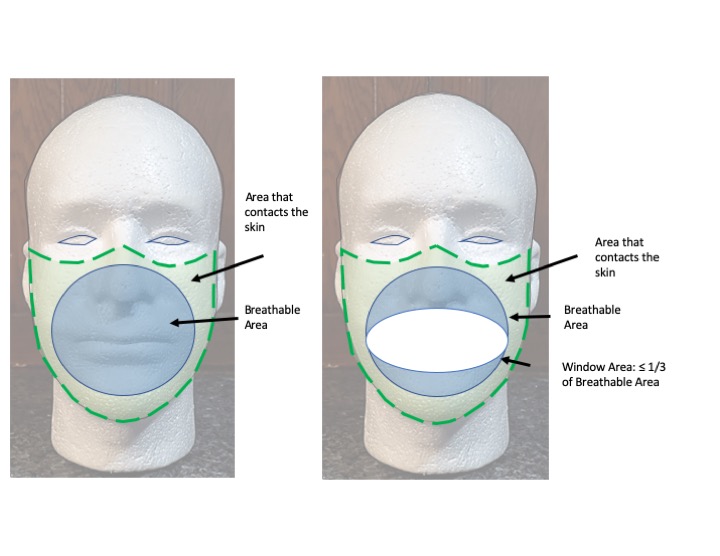
Window material should not touch the mouth or nose. Since current clear plastics used as window materials are not breathable, it is important that they do not block a user’s airways. As such, mask designs which have extra volume around the mouth and nose to ensure sufficient access to breathable mask areas are crucial for window masks.
Pleats improve mask breathability and comfort. If large windows are used, look for modifications to the design that increase the breathable surface area, such as the addition of extra pleats. The reason many air filters and masks include pleats is to increase breathable surface area without decreasing the effective filtration. Consider designs with extra pleats around the clear windows. These will be more breathable.
#2 Window Materials
Rule of Thumb: If you wouldn’t eat off of it, don’t use it as a mask window.
Consider Food Safe Plastics. Ideally, mask window materials would be made from clear medical-grade materials approved for use in face masks. However, in situations where medical-grade materials are not available, consider food-grade (i.e., food contact safe) window materials. Although we are not planning on eating from our masks, the window materials in masks will be in warm, humid environments in close proximity to the mouth. Food-safe clear plastic materials are commonly available, subject to regulatory controls, and undergo safety testing for contact with things that humans put in their mouths. The plastics most commonly considered food-contact safe are polypropylene (PP), high-density polyethylene (HDPE), low-density polyethylene (LDPE), and polyethylene terephthalate (PET or PETE). If windows are going to be permanently affixed to the mask, consider materials that are labeled “microwave safe” and “reusable” as they are more likely to be compatible with cleaning and disinfection methods. In general, look for materials that are clear, flexible, shatter resistant, and non-toxic. Avoid materials that off-gas, or smell funny, and materials that are brittle.
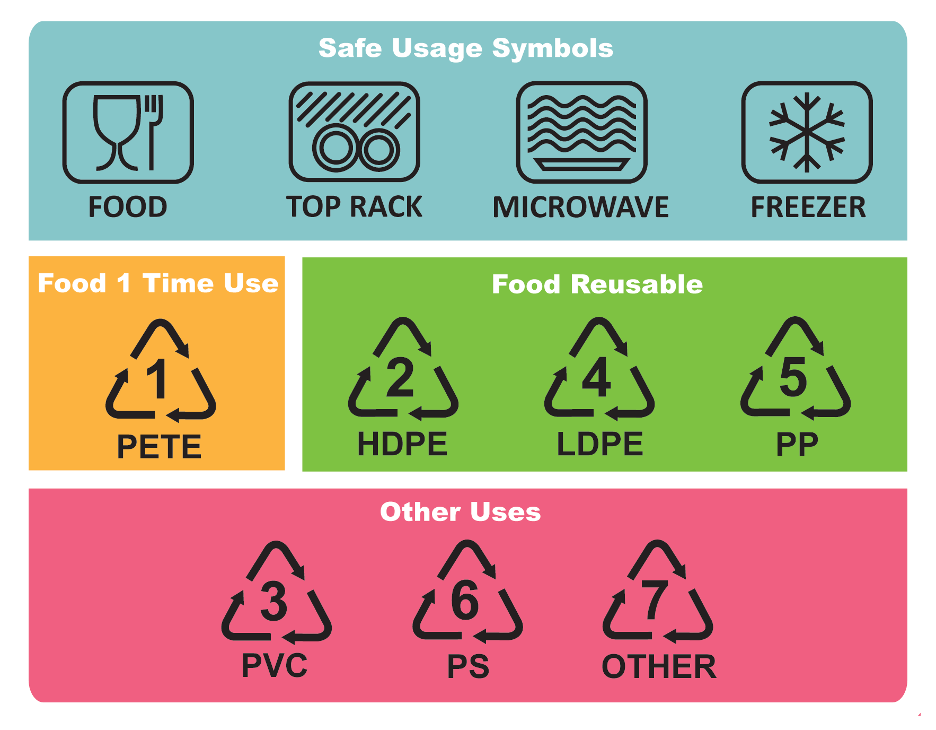
Top Material Choices: The form and thickness of the specific window materials (typically plastics) used will vary depending on the specific mask design, the way the window will be attached to the mask, and the desired/required cleaning and disinfection methods. Check out the table below for a Deeper Dive into the suitability of clear plastics for window masks.
| Category | Rating | Details |
| Usually Food-Safe | Best | Polypropylene (PP): commonly available in food safe containers such as sous vide bags (2 – 3 mil thickness) and other heat-safe clear reusable bags. Thin, flexible PP is easy to heat-seal to spunbond nonwoven polypropylene materials and is the preferred material for heat-sealed masks. ● Look for “microwave-safe” or “boil safe” ● Generally considered reusable ● Usually compatible with hot water washing (melting point: ~160 C) ● Recycling #5 |
| Good | High Density Polyethylene (HDPE): flexible and commonly available in food safe sous vide bags and freezer bags. Do NOT steam! ● Moderate Temperature Uses (melting point: ~120C) ● May be considered reusable ● Recycling #2 |
|
| Good | Polyethylene Terephthalate (PET): commonly available around the globe in plastic soda bottles (~17 mil thickness). Rigid and holds shape well for no-sew options (7 mil to 17 mil). Avoid heat. ● Semi-Rigid, Low Temperature Uses, commonly recyclable ● Generally considered single-use ● Recycling #1 |
|
| Less Good | Low Density Polyethylene (LDPE): commonly available in clear plastic wrap and sandwich bags. Lower melting points (~105C) makes it unsuitable for boiling or other high-heat disinfection strategies. Avoid heat. ● Thin, flexible and not very durable, and rarely recyclable. Not Ideal. ● Generally considered single-use ● Recycling #4 |
|
| Not Usually Food Safe | Caution | Vinyl (V)*: Vinyl (polyvinyl chloride), is commonly used in shower curtains, but is not usually considered food safe. Check regulations on suitability for food contact. Caution recommended. Avoid heat. Do NOT laser cut. ● Avoid use in masks; Consider other options if available. ● Recycling #3 |
*See Appendix 1 for more information
Although HDPE and LDPE are considered separately for recycling, in common applications such as freezer bags, the ingredient list says “polyethylene” and doesn’t distinguish between the two types.
#3 Window Attachment Method
Rule of Thumb: Avoid holes in the center area of the mask and gaps between the window and mask fabrics
Attaching the window to the mask is where most fabrication challenges arise. You want to minimize leaks around the window, which means minimizing gaps, holes, and seams. Carefully inspect the area around the window of the masks for holes and/or gaps after construction and before each use.
Window attachments methods can be divided into three general categories: sealed-in windows, sewn-in windows, and removable windows.
Sealed-in Windows
Sealed-in windows (e.g., the MakerMask: Expression) use heat sealed seams to securely bond the window material to the mask fabric. This method requires careful selection of compatible window materials and mask fabrics (e.g., synthetic materials like polypropylene, polyethylene etc) and a vacuum seal or other tool for making the seals (e.g., an ultrasonic welder). Heat sealing is our preferred technique because it is designed to provide an air-tight seal between the window and the mask body, which helps prevent leaks.
- Preferred window material: food grade polypropylene; thickness ~3 mil works well
- Secondary window material: heavyweight polypropylene sheet protectors, preferably acid-free archival grade, >3 mil
- Preferred mask fabric: spunbond NWPP (not suitable for natural fibers like cotton
- Advantage: can provide an air-tight seal between the window and the mask body, which helps prevent leaks
- Disadvantage: Requires careful selection of compatible materials. Likely less durable than sewn-in window options; care should be taken while washing; see section on cleaning and disinfection below.
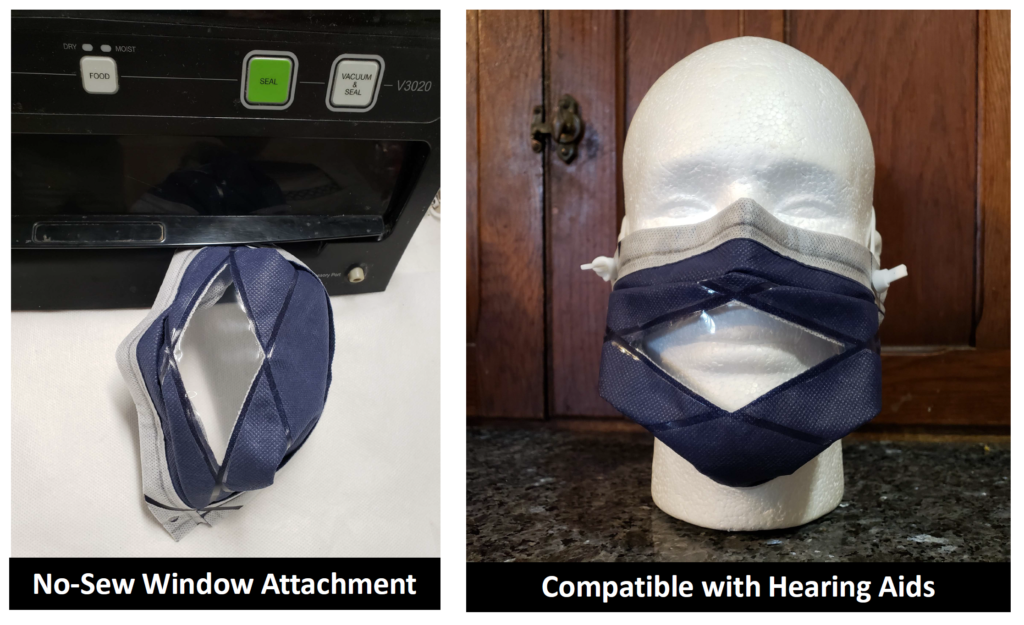
Sewn-in Windows
Sewn-in windows (e.g., the Happy Turtle Mask) are compatible with a wide range of materials, and are the most commonly available window mask patterns. When using sewn-in window masks, holes are a primary concern. Be sure to inspect the area around the window to ensure that stitch lines are covered to minimize the risk of germs getting an express ride from one side of the mask to the other through the needle holes.
- Preferred window material: Food-safe flexible plastics (PP, PE), thick enough to support sewing
- Preferred mask fabrics: Compatible with most mask fabrics (e.g., cotton or NWPP)
- Advantage: quick and easy to make using tools and strategies familiar from other mask making efforts
- Disadvantage: Usually introduces needle holes into the window material; verify that water and/or light do not pass through seams around the window material.
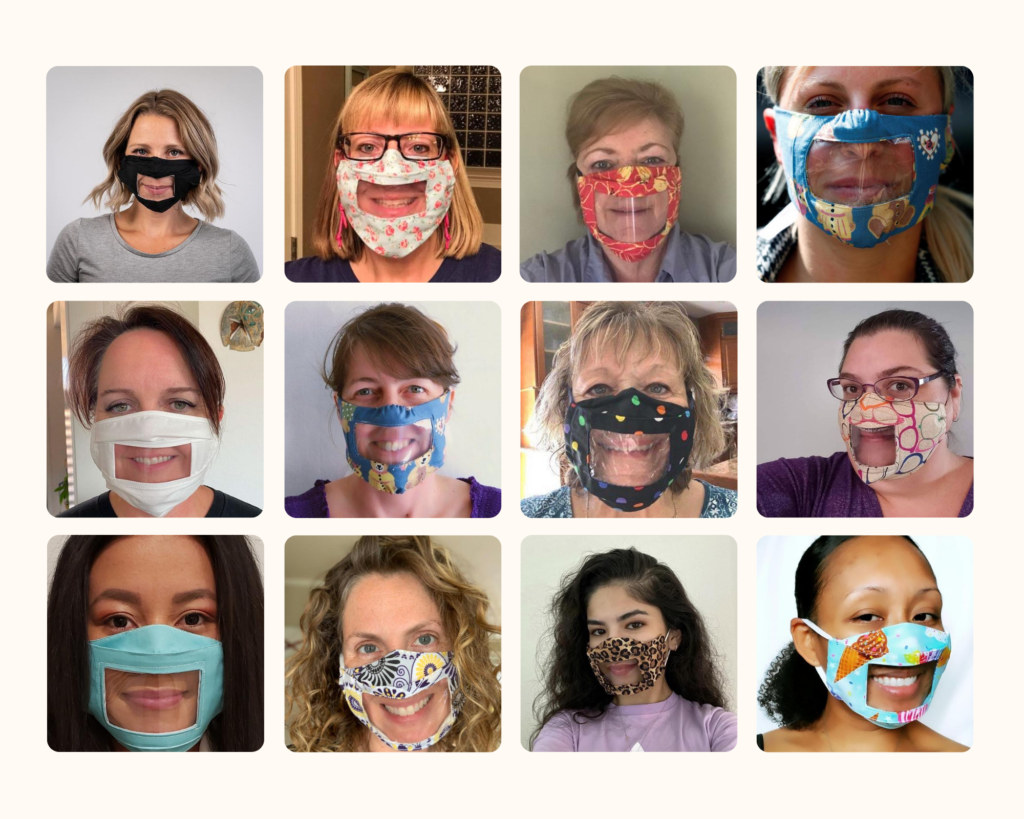
Removable Windows
Removable windows (e.g., “MakeIt Clearly Heard Mask) allow the window materials to be disposed of/cleaned/disinfected separately from the mask body. These designs require more attention to detail in both use and construction. For designs where the windows slip in between mask layers, sealing may require gaskets or large overlapping areas to reduce leakage. Rigid, or semi-rigid window materials are preferred for these types of designs.
- Preferred window material: food safe PET such as that used in soda bottles and face shields (>7 mil thickness required; 17 mil works); generally considered disposable
- Preferred mask fabric: Compatible with most mask fabrics (e.g., cotton or NWPP); fabric mask body may be reused
- Advantage: window materials can be easily replaced when dirty or damaged, while the mask body is reusable
- Disadvantage: Challenging to get good seals between window and fabric. Make sure there are no gaps between window and mask
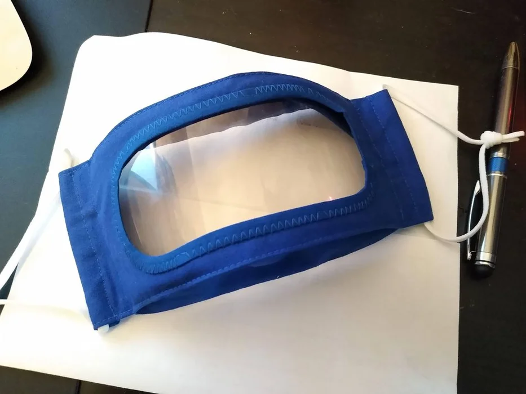
Regardless of which attachment method is used, it is important to think about where the window material is mounted onto the mask (i.e., is it mounted to the outermost layer? the innermost layer?) If possible, consider having the window mounted to the outermost layer so that anything that hits the plastic from the outside drips off of the mask instead of into it.
#4 Cleaning and Disinfection
Rule of Thumb: If you’re not sure if it can be safely reused, consider it disposable.
For window masks that are intended for reuse it is important to pay close attention to the instructions for cleaning and/or disinfection. This is especially true for masks with permanently attached windows since the best strategies for disinfecting the mask fabrics are frequently different from those for washing the window materials.
- When buying a window mask, pay attention to the washing and disinfection instructions that come with your mask.
- If you are making window masks, always include instructions for how to clean both the fabric and the window material. You should also include the type of plastic that the window is constructed from.
Consider cleaning methods that involve minimal agitation of the window material such as gently hand washing it, or washing on delicate in a lingerie bag. Before each use, carefully observe window materials and areas where windows and masks are joined to ensure that gaps and/or holes have not developed.
Finally, it is important that although most polypropylene window materials as well as some microwave-safe polyethylene materials may be compatible with heat-based disinfection methods, most other clear window materials are not. For example, PET may warp and smell funny when exposed to high temperatures, and vinyl can release toxic byproducts when heated. For more information about cleaning and disinfection, see “Fabric Face Masks: Cleaning and Disinfection.”

#5 Window Fogging
One of the challenges with window masks is that the windows fog easily and accumulate moisture. For mask makers and designers, increasing the breathable surface area of the mask fabric may help reduce fogging, and using anti-fog window materials can also help.
For mask users, anti-fog window coatings may be an option. These coatings are usually surfactants, which help prevent water from beading up on the surface of the window by decreasing the surface tension of the window.
The most common work-around for dealing with window fogging is to add a drop of surfactant (e.g., lotion-free dish soap or baby shampoo) and spread it evenly across the face-side surface of the window material to reduce fogging (to improve the optical clarity, after the detergent dries, buff it with a soft cloth). This approach is effective at reducing fogging, but may leave you with a bitter taste in your mouth … a bit like getting your mouth washed out with soap 😉
- Allergy consideration: If using soap as an anti-fog agent, make sure that all soap residue is rinsed out of mask materials between uses as soap residue is a common cause of dermatitis. Use fragrance free, hypoallergenic options wherever possible, and consider other surfactants if available.
- Water resistant materials. For water-resistant mask materials (e.g., NWPP), the soap residue that prevents water from beading up on the surface of the window may also prevent water from beading up on the surface of the NWPP. Take care to limit your application area and rinse well between uses.
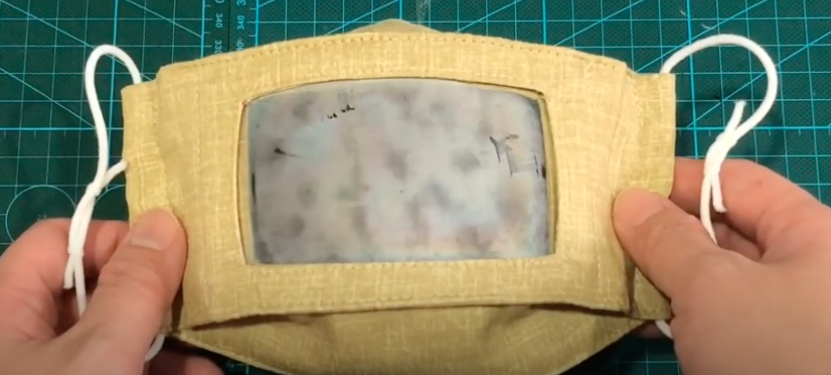
Pensamientos Finales
As interest in window masks continues to grow, more patterns are emerging. We are working with groups like OSMS, WeHaveMasks, MakeIt Labs, Helpful Engineering, and other organizations to develop improved window mask designs and will update this page as those become available.Do you have a favorite window mask design? What is the material you are using for the window? How are you keeping them from fogging up? Join the discussion on our Facebook page at www.facebook.com/themakermask.
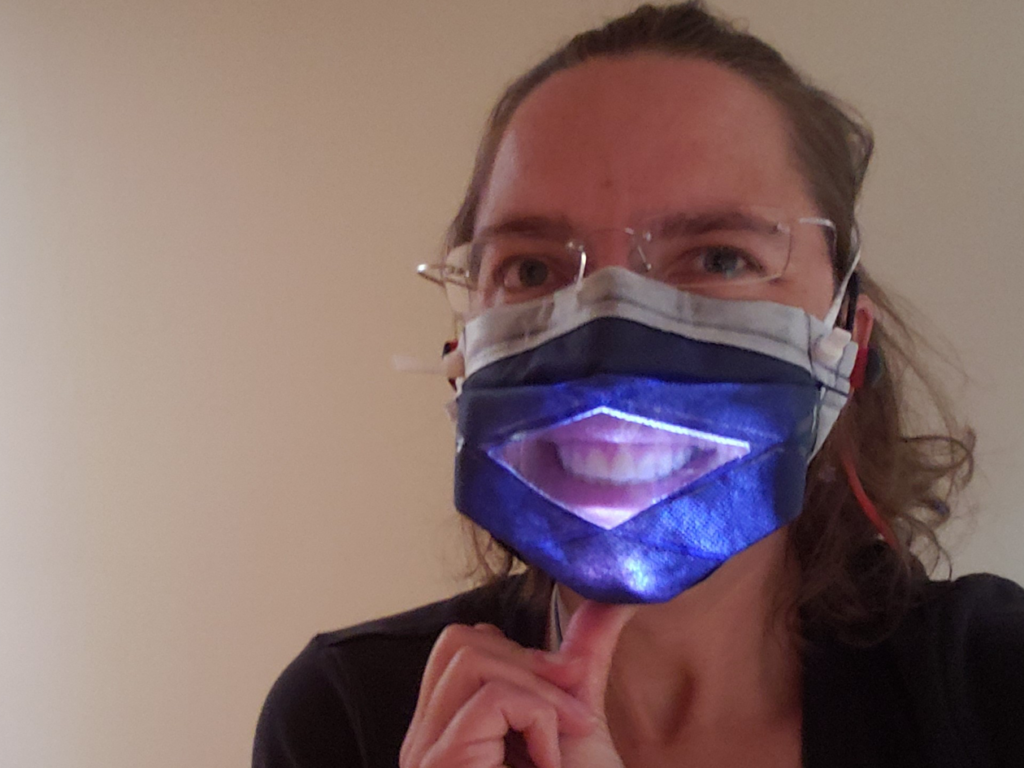



4 pensamientos en “5 Key Considerations For Window Masks”
Comentarios cerrados.